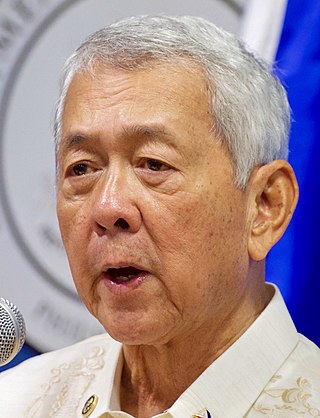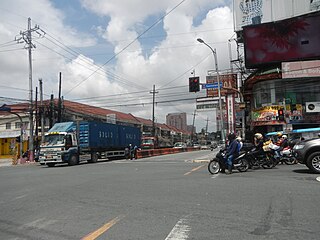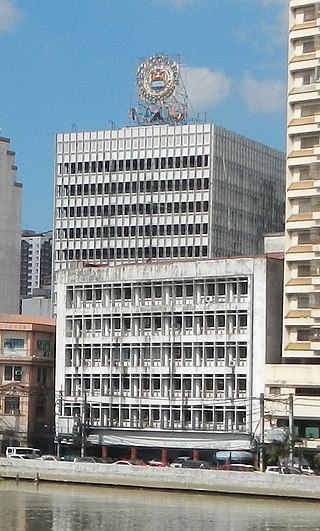
Manila, officially the City of Manila, is the capital and second-most populous city of the Philippines, after Quezon City. Located on the eastern shore of Manila Bay on the island of Luzon, it is classified as a highly urbanized city. Manila is the world's most densely populated city proper, with 43,611.5 inhabitants per square kilometer (112,953/sq mi) and a population of 1,846,513 people in 2020; it is also the historic core of a built-up area that extends well beyond its administrative limits and includes some 24 million people. Manila was the first chartered city in the country, designated by Philippine Commission Act No. 183 on July 31, 1901. It became autonomous with the passage of Republic Act No. 409, "The Revised Charter of the City of Manila", on June 18, 1949. Manila is considered to be part of the world's original set of global cities because its commercial networks were the first to extend across the Pacific Ocean and connect Asia with the Spanish Americas through the galleon trade. This marked the first time an uninterrupted chain of trade routes circling the planet had been established.

Joseph "Erap" Ejercito Estrada is a Filipino politician and former actor, who served as the 13th President of the Philippines from 1998 until his removal in 2001, the 9th Vice President of the Philippines from 1992 to 1998, and the 22nd Mayor of Manila from 2013 to 2019, also served as the 14th Mayor of San Juan from 1969 to 1986. In 2001, he was formally impeached from the Presidency as a result of the Second EDSA revolution; he became the first chief executive in Asia to be impeached.

The Second EDSA Revolution, also known as the Second People Power Revolution, EDSA 2001, or EDSA II, was a political protest from January 17–20, 2001 which peacefully overthrew the government of Joseph Estrada, the thirteenth president of the Philippines. Following allegations of corruption against Estrada and his subsequent investigation by Congress, impeachment proceedings against the president were opened on January 16. The decision by several senators not to examine a letter which would purportedly prove Estrada's guilt sparked large protests at the EDSA Shrine in Metro Manila, and calls for Estrada's resignation intensified in the following days, with the Armed Forces withdrawing their support for the president on January 19. On January 20 Estrada resigned and fled Malacañang Palace with his family. He was succeeded by Vice President Gloria Macapagal Arroyo, who had been sworn into the presidency by Chief Justice Hilario Davide Jr. several hours earlier.

The Philippine Daily Inquirer (PDI), or simply the Inquirer, is an English-language newspaper in the Philippines. Founded in 1985, it is often regarded as the Philippines' newspaper of record. The newspaper is the most awarded broadsheet in the Philippines and the multimedia group, called The Inquirer Group, reaches 54 million people across several platforms.

Halo-halo, also spelled haluhalo, Tagalog for "mixed", is a popular cold dessert in the Philippines made up of crushed ice, evaporated milk or coconut milk, and various ingredients including side dishes such as ube jam, sweetened kidney beans or garbanzo beans, coconut strips, sago, gulaman (agar), pinipig, boiled taro or soft yams in cubes, flan, slices or portions of fruit preserves and other root crop preserves. The dessert is topped with a scoop of ube ice cream. It is usually prepared in a tall clear glass and served with a long spoon. Halo-halo is considered to be the unofficial national dessert of the Philippines.

Alfredo "Fred" Siojo Lim was a Filipino politician, police officer and lawyer who served as a Senator of the Philippines from 2004 to 2007, He also served as the 20th Mayor of Manila twice: first from 1992 to 1998, and again from 2007 to 2013.

Perfecto Rivas Yasay Jr. was a Philippine government official who served as Secretary of Foreign Affairs of the Philippines under the Duterte administration in an ad interim basis from June 30, 2016, until March 8, 2017, the rejection of his appointment by the Commission on Appointments over eligibility concerns resulting from questions on his citizenship.

The May 1 riots, or EDSA III, were protests sparked by the arrest of newly deposed president Joseph Estrada of the Philippines from April 25 to May 1, 2001. The protest was held for 7 days on a major highway in Metro Manila, Epifanio de los Santos Avenue (EDSA), which eventually culminated in an attempt to storm the Malacañang Palace.

The Rizal Memorial Sports Complex is a national sports complex of the Philippines, located on Pablo Ocampo St., Malate, Manila. It is named in honor of the country's national hero, José Rizal (1861–1896). The complex is currently managed by the Philippine Sports Commission, while the property is owned by the Manila City government. The complex also houses the administrative office of the PSC, and quarters for the Philippines' national athletes.

Divisoria is a commercial center in the districts of Tondo, Binondo, and San Nicolas in Manila, Philippines known for its shops that sell low-priced goods and its diverse manufacturing activities. Tutuban Center is situated within the commercial hub along with a night market located in the Centers' vicinity. The area is riddled with different bazaars, bargain malls, and a few points of interest.

Plaza Miranda is a public square bounded by Quezon Boulevard, Hidalgo Street and Evangelista Street in Quiapo, Manila. It is the plaza which fronts the Minor Basilica and National Shrine of Jesus Nazareno, one of the main churches of the City of Manila and is considered the center of Quiapo as a whole. Inaugurated in its current form by Mayor Arsenio Lacson in 1961, it is named after José Sandino y Miranda, who served as the Philippines' Secretary of the Treasury between 1833 and 1854.

The Rizal Memorial Coliseum is an indoor arena in the Rizal Memorial Sports Complex in Manila, Philippines. It can hold up to 6,100 people.
The trial of Philippine president Joseph Estrada took place between 2001 and 2007 at the Sandiganbayan. Estrada resigned from office in 2001 during a popular uprising in Metro Manila after an aborted impeachment trial in which he was charged with plunder and perjury. Soon after his ouster, the same charges were filed against him at the Sandiganbayan.

The Manila Zoo, formally known as the Manila Zoological and Botanical Garden, is a 5.5-hectare (14-acre) zoo located in Malate, Manila, Philippines. First opened on July 25, 1959, it was recently renovated and reopened on November 21, 2022.

Francisco Moreno Domagoso, also known as Isko Moreno Domagoso or simply Isko Moreno, is a Filipino politician, actor, host and entrepreneur who served as the 23rd Mayor of Manila, the capital city of the Philippines, from 2019 to 2022. Before entering politics, Moreno first gained notability as an actor and television personality.

The 2010 Philippine presidential and vice presidential elections were held on Monday, May 10, 2010. The incumbent President of the Philippines, Gloria Macapagal Arroyo, was ineligible to seek re-election as per the 1987 Constitution.

Local elections were held in Manila on May 13, 2013, within the Philippine general election. The voters elected for the elective local posts in the city: the mayor, vice mayor, the six congressmen, and the councilors, six in each of the city's six legislative districts.

Janet Lim-Napoles is a Filipina businesswoman who is believed to have masterminded the Priority Development Assistance Fund (PDAF) Scam. She was convicted of plunder for her involvement in the PDAF Scam and is facing charges for alleged involvement in the misuse of the Malampaya fund for disaster response operations.

Granada Street is a road in Quezon City, Metro Manila, Philippines. It runs from Nicanor Domingo Street, as an extension of Gilmore Avenue, to the boundary with San Juan, where it terminates at Bonny Serrano Avenue and becomes Ortigas Avenue. The street is sometimes considered part of Ortigas Avenue by motorists.

The old Philippine National Bank (PNB) Building was a former office building along Escolta Street in Manila, Philippines.


























